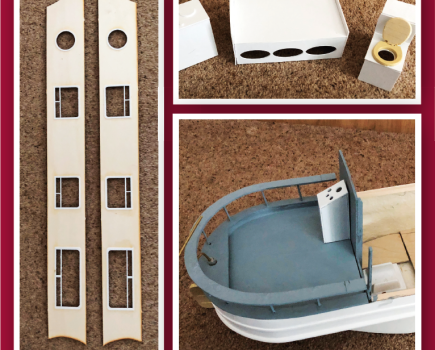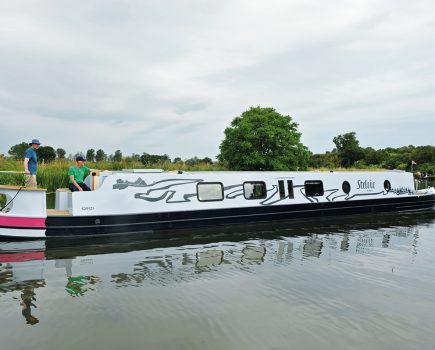Honeysuckle is a collaboration between the owner, Brayzel Boats who built it, and Daisy Boats who’ll be hiring it out for UK canal holidays

Not all holiday hire boats have to follow the familiar form. 2020 was a rollercoaster year for hire boat fleets. Lockdown was a disaster: with people unable to go on holiday, bookings had to be cancelled and boats sat idle. But when lockdown was eased, things took off in an extraordinary way – for much of the late summer and autumn you couldn’t hire a boat for love nor money. People who were unable to go abroad looked for UK holidays, and many of the national newspapers featured boating breaks as the perfect staycation. What’s more, it looks as though things will be pretty good in 2021 as well.
Many fleets are reporting that bookings are way ahead of usual – and some are looking to expand to meet the demand. That’s where this boat, Honeysuckle, comes in. What many people don’t realise about hire fleets, is that a good proportion of the boats are owned not by the firm running the fleet, but by individuals. They’re called sponsored boats and the idea is that someone buys a boat, puts it into a hire fleet for a few years, gets income from it while it’s working, and then at the end of the contract the boat is theirs to take away.
The big nationwide hire companies have their boats in standard layouts and corporate colours, but lots of the smaller independent firms don’t. This boat, for example, will look very much like a private boat while it’s in service, and has been built to the specification of the owner, while taking the needs of hire customers into account.
Honeysuckle is a collaboration between the owner, Brayzel Boats who built it, and Daisy Boats who’ll be hiring it out.

Exterior
Honeysuckle is based on a 58ft shell by Tyler Wilson. It’s one of their Mike Christian branded boats, which is the name they give to their less expensive shells, so you don’t get decorative features such as scrolls in the handrails and cants. But they still have the same underwater shape, with good long swims, which is what makes a Tyler Wilson boat handle so well.
And this boat also has some very bespoke changes to the shell, to take account of the fact that the owner has a disability. For example, there’s a finger grip along the handrail to give something extra to hang on to when walking down the gunwales. And the stern deck is completely flat, with no cants at all, to remove potential trip hazards. Because of this, though, there’s an extra step down into the boat. The deck is surrounded by a simple rail. There are lockers either side of the doors into the boat, to hold a gas bottle and a spare.
The hire company wasn’t keen on customers having a bow thruster to play with, so the control box has been made removable: when it’s connected, it sits safely on top of the column which carries the Morse control, held by a strong magnet.
A feature of Tyler Wilson shells is the chute weed hatch. The design, which completely separates the weed hatch from the rest of the boat, means it’s impossible to sink the boat simply by not putting the hatch back properly. This is undoubtedly a plus when the boat is going to be used by hirers, who may not have boated before.
However, because the deck is a little higher than usual, the prop is a long way down: you need pretty long arms to be able to reach down comfortably.

The well deck is lowered, so there’s just a single step up from the front cabin, meaning the doors can be taller. The deck itself is lower than the level of the canal, so drainage of rain water is an issue.
In years gone by, boats with lowered well decks often had pipes running the entire length of the boat, to carry rain water to the engine hole bilge, from where it could be pumped out.
It wasn’t a very satisfactory solution though: the drainage holes often got blocked meaning the well deck filled up; it’s not ideal deliberately putting extra water into the engine bilge; and in one notorious case the pipes corroded, resulting in rain water being deposited inside the boat.
So Andrew Crook of Brayzel has come up with a better solution. For a start, the drain holes are big and therefore less likely to become blocked (and making sure they’re clear will be part of the regular changeover day checks). They lead to a 75-litre stainless steel tank under the deck which will collect the rain water. This is fitted with an automatic bilge pump – and a backup pump, just in case. Andrew’s tests suggest the system could cope with rain storms of biblical proportions.
There are lockers each side of the well deck for storage, while the one across the deck gives access to the bow thruster. Together, they make a nice seating area. There are little LED deck lights, too, as there are at the stern. As the gas is at the stern, the nose contains a large integral water tank.
The colour scheme is a traditional dark blue with cream. All the trim is chrome, which is far easier to keep clean than brass. The window frames and portholes are by Cauldwells.

Layout and fitout
This boat fits a lot into its length – and the layout is designed so that it can be given the highest hire boat rating, which requires that everyone can get to a loo without having to walk past someone else’s bed. It’s a reverse layout, with the galley at the stern, followed by an L-shaped dinette which converts into a double bed. Next comes a tiny loo, followed by the main cabin. A walk-through shower room is next, with a saloon or second cabin at the bow.
The fitout uses a combination of oak panels below the gunwales, and painted ones above. The painted ones are actually the same oak, so the grain can still be seen. The floor is a lovely engineered oak.
Brayzel Boats always produce really good quality fitouts, and this boat is no exception. All the furniture is well made, and everything fits together perfectly.

Galley and dinette
Three ladder-style steps lead down from the stern deck into the galley, and there’s a radiator behind them to counteract any draughts through the rear doors. On one side is the electrical cupboard, while there’s a cupboard for coats opposite.
The galley has a simple layout, with a run of units each side of the boat, under laminate worktops. One side there’s a stainless steel sink and drainer, while on the other side there’s a full-size Belling oven. The hob is a four-burner model by Focal Point, and the 240v fridge is from Indesit. There’s a useful built-in wine rack, and a can cupboard makes use of the space under the gunwales.
The dinette is L-shaped and converts easily into a double bed. It’s raised so the view out the windows is better, and there are drawers underneath. There’s a cupboard in the end of the base unit, designed to be used for a small freezer when the boat’s hire days are over. A set of side doors makes this a pleasant place to sit.

Second loo
This is by any measure a small room – but it’s still perfectly big enough. The toilet is a Thetford cassette, which is perhaps an unusual choice for a hire boat, as many hirers probably don’t want to spend their time locating and using an Elsan.
However, the other toilet on board is a pump out, so if that gets blocked, this loo gives the occupants another option. The toilet itself is the model with a porcelain bowl, and without the high back, meaning it looks much more like a normal loo.
A small rectangular basin sits on a slim unit, just big enough to wash your hands. A nice touch is low level LED coloured lighting, which provides enough light at night that you don’t have to wake everyone else up by putting on the main lights.

Main cabin
A wardrobe provides space for clothes, and at floor level gives access to the loo cassette. The bed is inline and the base houses the holding tank for the other toilet. It’s positioned as close as possible to the centre line of the boat, so the trim won’t be affected as it fills. A high level cupboard is above the head of the bed, with reading lights underneath.

Shower room
A generously sized quadrant shower is the main feature of the room, but unusually it has no screen or doors. This is because of the boat owner’s disability. Instead, there’s a shower curtain – although Andrew Crook found it impossible to source a curved rail to hang it on; he had to have one specially made.
The basin sits on a vanity unit with a mirror above, while the toilet is a pump out model by Sanimarine. The floor is ceramic tiles. More low-level night lighting is provided.
Saloon/second cabin
This room is properly dual purpose, because it’s both a pleasant saloon and a twin cabin. Built-in sofas either side of the room double as single beds. Each one has a tall wardrobe at one end, giving plenty of storage space, and there’s more space in the bases.
What makes this feel more like a saloon than just another bedroom is a TV unit in one corner and a Hobbit stove in the other. This has a double insulated flue and a nicely tiled hearth and surround. This would make a great bedroom for children, but if it’s not needed as a cabin it would be be a nice place to escape for the evening.
Technical
Honeysuckle is powered by the ubiquitous Beta 43 engine. The bow thruster, when it’s connected, is a 75kgf model by Vetus. There are five 110Ah domestic batteries, plus one for the engine and two for the bow thruster.
Andrew has opted for Victron gel batteries, partly to see how they cope with the demands of hire boaters. Most hirers probably won’t give charging regimes a thought and are unlikely to be checking their voltages, so the batteries may take a bit of a beating. It will be interesting to see how long they last. A 240 volt supply comes from a 1.6kw Victron inverter charger. This is small compared with most inverters we see these days, but this boat doesn’t have fixtures such as a washing machine.
The central heating is by a Webasto diesel boiler.
On the water
A Tyler Wilson shell and a Beta 43 means there are few surprises when under way. The boat handles well, and we turned around without needing the bow thruster. The engine is nice and quiet, and there’s plenty of space on the back deck for helmsman and crew.
As is often the case with cruiser stern boats, the Morse control is mounted on a little column to one side, and is lower than it would be on a trad or semi-trad.
Image(s) provided by:
Archant







